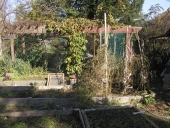




 1
1




Support my videos by becoming a Patron
QR code for Bitcoin donations
www.oneheartfire.org to follow my personal permaculture adventures.
Now accepting Gappers for the Permaculture Bike Park project.
My Ant Love wish list:
Biodegradable Bar Oil for my chainsaw. I'm gonna need a lot of this for milling lumber with my chainsaw mill.
Darn Tough Socks that come with an unconditional lifetime warrantee! I go through socks like goats through a fence, these are supposed to last a lifetime or they send you a new pair! Size 12/XL please








Living in Anjou , France,
For the many not for the few
http://www.permies.com/t/80/31583/projects/Permie-Pennies-France#330873

 2
2









Jesse Grimes wrote:Most goji berries that are sold in bulk at health food stores are actually wolf berries, as goji berries have not been successfully cultivated and the commercially available ones are wild crafted.
Pecan Media: food forestry and forest garden ebooks
Now available: The Native Persimmon (centennial edition)
 1
1




Dan Boone wrote:
Jesse Grimes wrote:Most goji berries that are sold in bulk at health food stores are actually wolf berries, as goji berries have not been successfully cultivated and the commercially available ones are wild crafted.
I have been wondering about this since Jesse posted it. We're just throwing around common names here so it's hard to be precise, and I'm really ignorant. Are they two different species? Or two different common names applied to domestic cultivars and wild exemplars of the same species? Is there any practical difference?
I planted some berries-labelled-goji last summer and got lots of finger-tall seedlings, but none of them survived my brown thumb to get through the heat of the summer.
 ...they germinated well but definitely didn't like our summers at least the first year. The ones that I have that survived lived in pots on the north side of the house with hardly any sun. I brought half of them inside for the winter and they are *surviving*. I look forward to spring to see if they thrive or not.
...they germinated well but definitely didn't like our summers at least the first year. The ones that I have that survived lived in pots on the north side of the house with hardly any sun. I brought half of them inside for the winter and they are *surviving*. I look forward to spring to see if they thrive or not."We're all just walking each other home." -Ram Dass
"Be a lamp, or a lifeboat, or a ladder."-Rumi
"It's all one song!" -Neil Young




"We're all just walking each other home." -Ram Dass
"Be a lamp, or a lifeboat, or a ladder."-Rumi
"It's all one song!" -Neil Young




Judith Browning wrote:...they germinated well but definitely didn't like our summers at least the first year. The ones that I have that survived lived in pots on the north side of the house with hardly any sun. I brought half of them inside for the winter and they are *surviving*. I look forward to spring to see if they thrive or not.
Pecan Media: food forestry and forest garden ebooks
Now available: The Native Persimmon (centennial edition)
 1
1




Yes, I'm that David The Good. My books are here: http://amzn.to/2kYcCKp. My daily site is here http://www.thesurvivalgardener.com and my awesome videos are here https://www.youtube.com/subscription_center?add_user=davidthegood
 1
1














|
Squanch that. And squanch this tiny ad:
Rocket Mass Heater Resources Wiki
https://permies.com/w/rmh-resources
|






